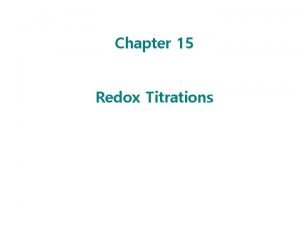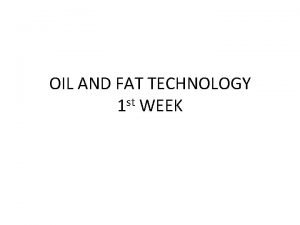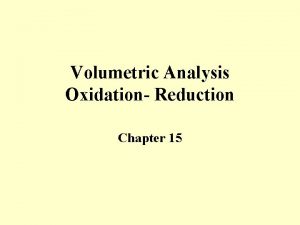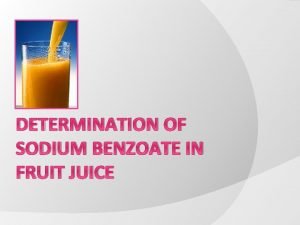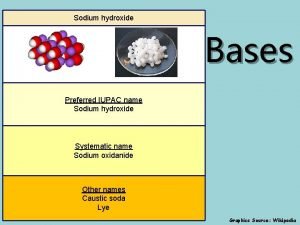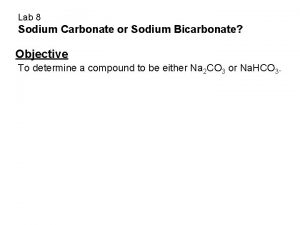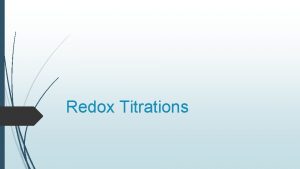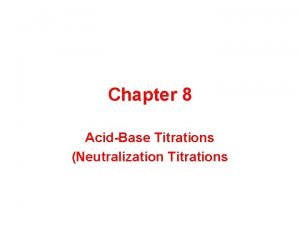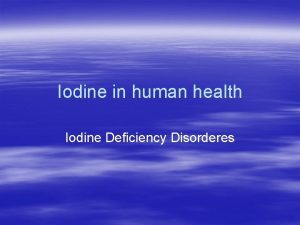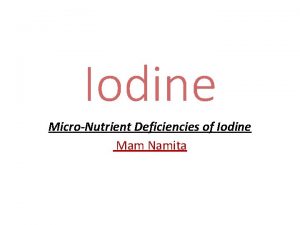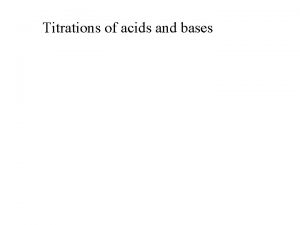METAMIZOLE SODIUM DETERMINATION IODIMETRY TITRATIONS WITH IODINE Iodine







- Slides: 7

METAMIZOLE SODIUM DETERMINATION IODIMETRY

TITRATIONS WITH IODINE • Iodine is a good oxidizing agent. Since Iodine/Iodide ((I 2/I-) has a standard redox potentials between strong oxidizing agent and strong reducing agent, it has a wide range of applications: • While strong oxidizing agent oxidize iodide anion (I- ) to iodine (I 2 ), strong reducing agents reduce iodine to iodide anion. • Since solubility of iodine in water is very low, KI is added to dissolve it by formation of I 3 - (triiodide) complex I 2 + I - I 3 • Since triiodide/iodide (I 3 -/I-) pair has same reduction potential with iodine/iodide (I 2/I-) pair (0, 54 V), I 2 can be written instead of I 3 - for avoiding confusion. • There are two type of iodine titrations: 1. 2. Iodimetry (Direct method Iodometry (Indirect method)

IODIMETRY AND IODOMETRY • Iodimetry (Direct method): In this method, a reducing agent is titrated with a standard iodine solution. Reaction medium either neutral or mild acidic. The analytes having standard reduction potentials lower than iodine/iodide pair are oxidized by iodine. • Iodometry (Indirect method): In this method, excess of iodide (I-) is added on an oxidizing agent (analyte) and iodine (I 2) is produced depending on the amount of analyte. Then produced iodine is titrated with standard thiosulfate (S 2 O 3 -2) solution. The advantage of this method is that even small amount of iodine can be easily observed because of the color of iodine. • Iodine reactions are not favored in alkali medium because internal redox reaction can be observed in alkali medium. • Starch is the indicator in iodine titrations. Starch and iodine form a complex having strong blue color. In iodimetry, end point is observed by blue color formation which is the result of starch-iodine complex after all analyte is consumed and unreduced iodine exist in the medium. On the other hand, in iodometry, since at the beginning of the titration there is iodine in the medium, blue color is observed at first. Then at the end point, since all iodine is reduced, blue color disappears.

STANDARDIZATION OF IODINE • Iodine solution is standardized with arsenite (As. O 3 -3) • Transfer 10 m. L of arsenite with known concentration to an erlenmeyer flask. • Add 1 g of Na. HCO 3. • Titrate with iodine and add 1 m. L of starch solution approaching the end point (ask your TA). • Continue to titrate until blue.

METAMIZOLE SODIUM DETERMINATION • Since metamizole sodium is unstable in water, a small amount of water is used for dissolving metamizole sodium and the titration is performed quickly. The reaction between metamizole sodium and iodine is an addition reaction:

• Weigh ten tablets that were given to your group and calculate the amount equivalent to one tablet. • Ground ten tablets in a mortar and transfer the amount equivalent to one tablet to an erlenmeyer flask. • Add 5 m. L of water and 5 m. L of 0. 02 M HNO 3 and begin titration with iodine solution without waiting. • Approaching to the end point (ask your TA), add 1 m. L of starch solution. • Continue titration until 2 min stable violet color is obtained.

CALCULATIONS • MW (metamizole sodium) = 334 g/mol Reference • Analitik Kimya Pratikleri – Kantitatif Analiz (Ed. Feyyaz Onur), A. Ü. Eczacılık Fakültesi Yayınları No. 111, 2014.
